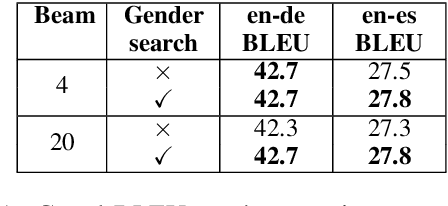Rosie Sallis
First the worst: Finding better gender translations during beam search
Apr 15, 2021



Abstract:Neural machine translation inference procedures like beam search generate the most likely output under the model. This can exacerbate any demographic biases exhibited by the model. We focus on gender bias resulting from systematic errors in grammatical gender translation, which can lead to human referents being misrepresented or misgendered. Most approaches to this problem adjust the training data or the model. By contrast, we experiment with simply adjusting the inference procedure. We experiment with reranking nbest lists using gender features obtained automatically from the source sentence, and applying gender constraints while decoding to improve nbest list gender diversity. We find that a combination of these techniques allows large gains in WinoMT accuracy without requiring additional bilingual data or an additional NMT model.
Neural Machine Translation Doesn't Translate Gender Coreference Right Unless You Make It
Oct 11, 2020



Abstract:Neural Machine Translation (NMT) has been shown to struggle with grammatical gender that is dependent on the gender of human referents, which can cause gender bias effects. Many existing approaches to this problem seek to control gender inflection in the target language by explicitly or implicitly adding a gender feature to the source sentence, usually at the sentence level. In this paper we propose schemes for incorporating explicit word-level gender inflection tags into NMT. We explore the potential of this gender-inflection controlled translation when the gender feature can be determined from a human reference, assessing on English-to-Spanish and English-to-German translation. We find that simple existing approaches can over-generalize a gender-feature to multiple entities in a sentence, and suggest an effective alternative in the form of tagged coreference adaptation data. We also propose an extension to assess translations of gender-neutral entities from English given a corresponding linguistic convention in the inflected target language.
 Add to Chrome
Add to Chrome Add to Firefox
Add to Firefox Add to Edge
Add to Edge